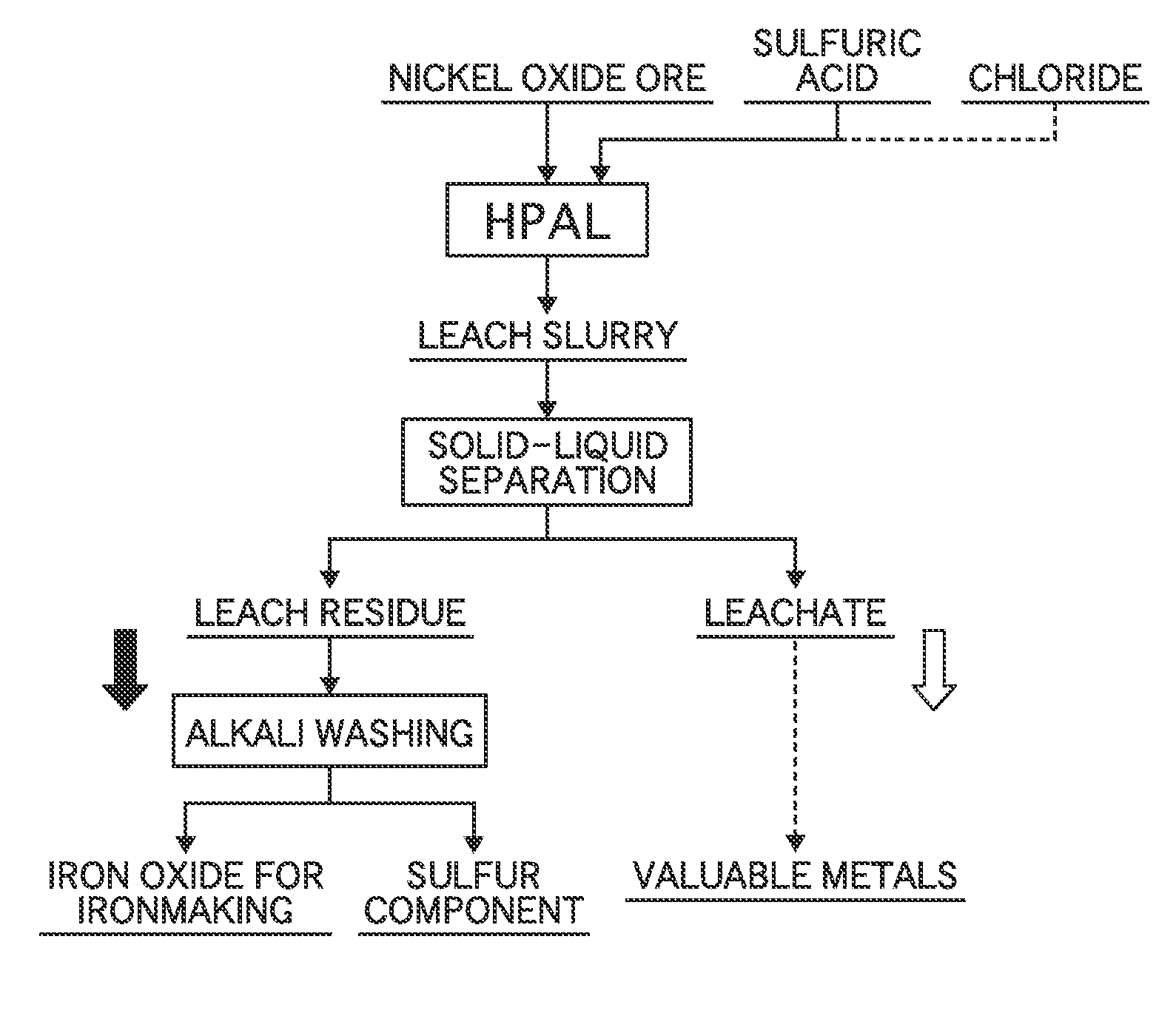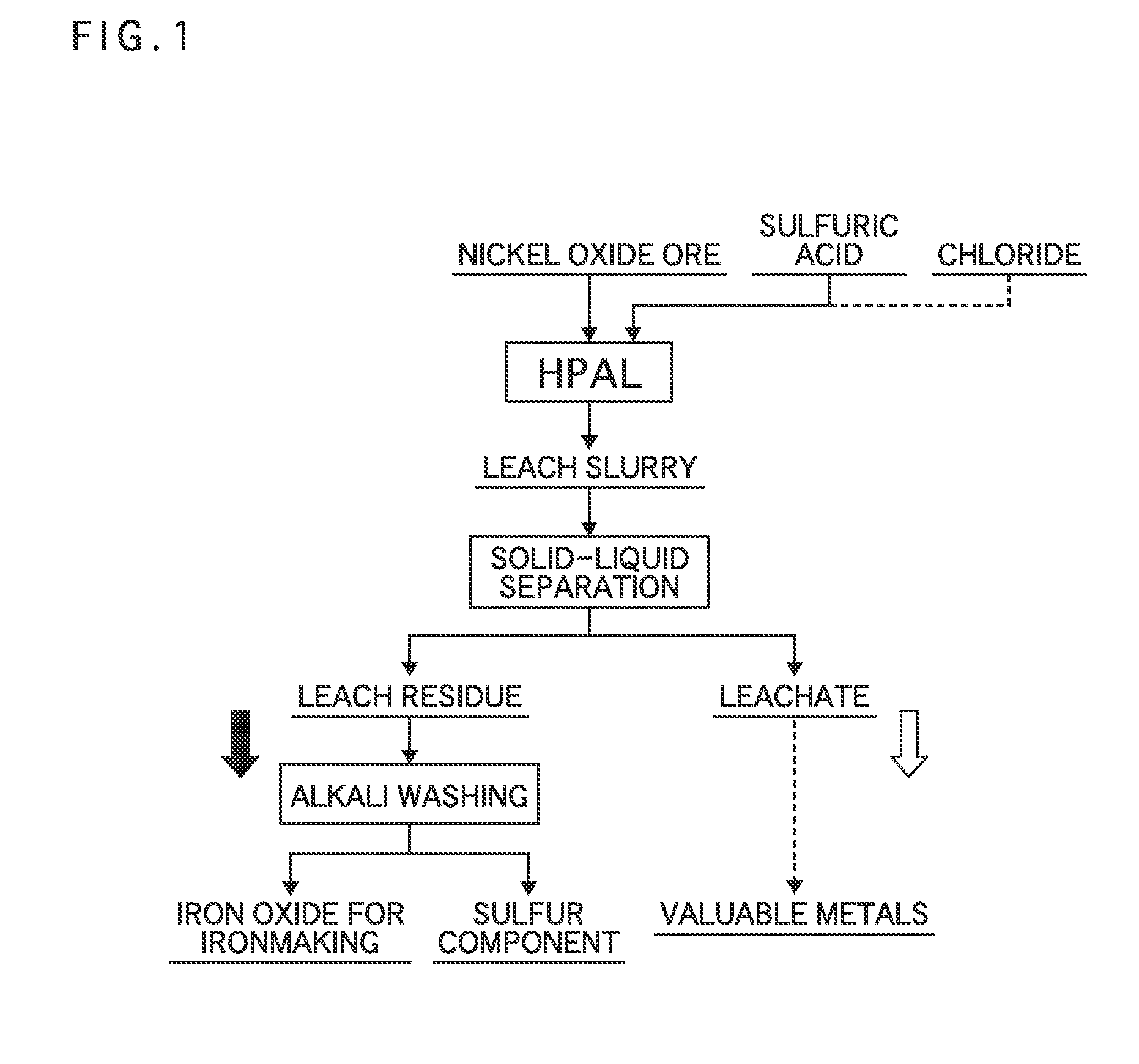Method for producing hematite for ironmaking
a technology of ironmaking and hematite, which is applied in the directions of solvent extraction, transportation and packaging, separation processes, etc., can solve the problems of limited resource of oxide as a raw material of steel, difficult to obtain high-quality iron ore required to maintain a quality of steel, and no special utility value of leach residues
- Summary
- Abstract
- Description
- Claims
- Application Information
AI Technical Summary
Benefits of technology
Problems solved by technology
Method used
Image
Examples
example 1
[0047]Nickel oxide ore having 1% nickel grade and 46 to 48% iron grade was adjusted to be a slurry of 30 to 40% by weight, and then sulfuric acid of 64% by weight was mixed to be 205 kg per ton of ore (205 kg / ore-t), which was smaller than that applied conventionally.
[0048]Subsequently, the mixed slurry was charged into a pressure device, heated to 240 to 250° C., and then held for three hours, and nickel in the ore was leached to form a leach slurry.
[0049]Next, solid-liquid separation was directly performed using Nutsche and a filtering bottle, and the leach slurry was separated into a leachate and a leach residue.
[0050]Table 1 shows an addition amount of sulfuric acid per ton of ore [kg / ore-t], a free acid concentration prior to the solid-liquid separation (represented as a slurry free acid concentration “g / l”), an amount of the sulfur component contained in the leach residue [% by weight] (represented as sulfur grade in residue [%]), and a Ni leach rate [%] calculated from an amo...
example 2
[0051]Example 2 was performed in the same way as Example 1, except that sulfuric acid added to nickel oxide ore was mixed to be 165 kg per ton of ore (165 kg / ore-t), and the sulfuric acid was subjected to solid-liquid separation into a leachate and a leach residue.
[0052]At this time, an addition amount of sulfuric acid per ton of ore, a free acid concentration prior to the solid-liquid separation (slurry free acid concentration), an amount of the sulfur component contained in the leach residue (sulfur grade in residue), and a Ni leach rate calculated from an amount of Ni contained in the leachate after the solid-liquid separation are shown in Table 1 together.
Conventional Example
[0053]Conventional Example was performed in the same way as Example 1, except that sulfuric acid added to nickel oxide ore was mixed to be 275 kg per ton of ore (275 kg / ore-t) which was in a conventional range, and the sulfuric acid was subjected to solid-liquid separation into a leachate and a leach residue...
example 3
[0058]In Example 1, an addition amount of sulfuric acid was set to 275 kg per ton of ore, and further magnesium chloride (MgCl2) was added to be a concentration of 14.3 g / l. The other conditions were the same as those of the Example 1. As such, Example 3 was performed and separated into a leachate and a leach residue, and the sulfur grade in the leach residue was measured.
[0059]As a result, due to the addition of the chloride, even though the added sulfuric acid was the same amount (275 kg / ore-t) as the case of Conventional Example shown in Table 1, the sulfur grade in the leach residue could be reduced to 0.99% without substantially changing the Ni leach rate.
PUM
| Property | Measurement | Unit |
|---|---|---|
| temperature | aaaaa | aaaaa |
| temperature | aaaaa | aaaaa |
| temperature | aaaaa | aaaaa |
Abstract
Description
Claims
Application Information
 Login to View More
Login to View More - R&D
- Intellectual Property
- Life Sciences
- Materials
- Tech Scout
- Unparalleled Data Quality
- Higher Quality Content
- 60% Fewer Hallucinations
Browse by: Latest US Patents, China's latest patents, Technical Efficacy Thesaurus, Application Domain, Technology Topic, Popular Technical Reports.
© 2025 PatSnap. All rights reserved.Legal|Privacy policy|Modern Slavery Act Transparency Statement|Sitemap|About US| Contact US: help@patsnap.com



